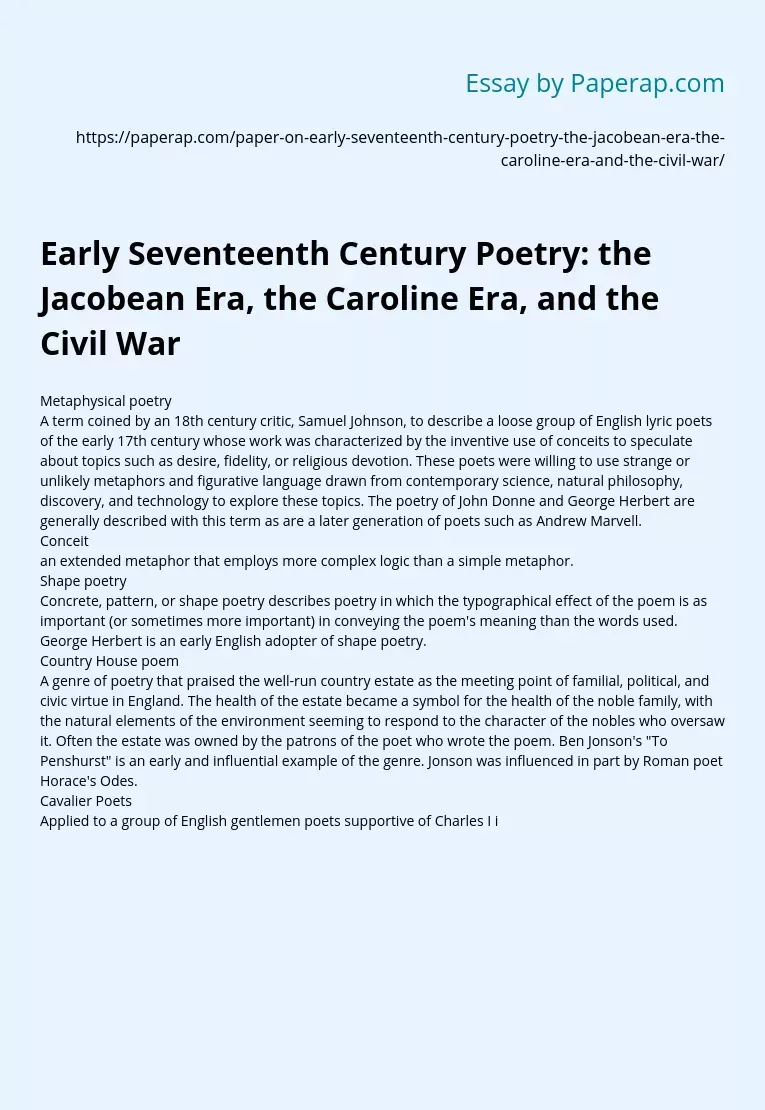17th Century Poetry & Wars
Topics:
American Literature
Essay,
Pages 3 (683 words)
Views
69
Metaphysical poetry
A term coined by an 18th century critic, Samuel Johnson, to describe a loose group of English lyric poets of the early 17th century whose work was characterized by the inventive use of conceits to speculate about topics such as desire, fidelity, or religious devotion. These poets were willing to use strange or unlikely metaphors and figurative language drawn from contemporary science, natural philosophy, discovery, and technology to explore these topics. The poetry of John Donne and George Herbert are generally described with this term as are a later generation of poets such as Andrew Marvell.
Conceit
an extended metaphor that employs more complex logic than a simple metaphor.
Shape poetry
Concrete, pattern, or shape poetry describes poetry in which the typographical effect of the poem is as important (or sometimes more important) in conveying the poem’s meaning than the words used. George Herbert is an early English adopter of shape poetry.
Country House poem
A genre of poetry that praised the well-run country estate as the meeting point of familial, political, and civic virtue in England.
The health of the estate became a symbol for the health of the noble family, with the natural elements of the environment seeming to respond to the character of the nobles who oversaw it. Often the estate was owned by the patrons of the poet who wrote the poem. Ben Jonson’s “To Penshurst” is an early and influential example of the genre. Jonson was influenced in part by Roman poet Horace’s Odes.
Cavalier Poets
Applied to a group of English gentlemen poets supportive of Charles I in his conflict with puritan ‘Roundheads’ who supported Parliament. Their poetry tended to focus on topics such as honor, the court, and dalliance in love. A common theme is carpe diem or ‘seize the day’ and a common trope is the use of shepherd and shepherdess names from classical Roman pastoral. Cavalier poetry is characterized stylistically by polish, elegance, sophistication, and easy wit. Included in this group are Robert Herrick, Richard Lovelace, Thomas Carew, Sir John Suckling, Edmund Waller.
“Sons of Ben”
The name attached to a circle of poets and dramatists cultivated by Jacobean poet and dramatist Ben Jonson. These poets – many of them also later Cavaliers – shared Jonson’s keen interest in controlling the printing/publishing of their own work and in reviving classical genres of writing such as public poems for friends, patrons, and occasions.
Pastoral
A genre of poetry – fluctuating in popularity and seriousness from the Elizabethan period through the reign of Charles I — that presents an idealistic, almost utopian vision of rural life. In these poems, shepherds and shepherdesses (sometimes mythological creatures such as fauns or nymphs) are innocent, pure, and free from corruption of the city or the royal court. Some common topics of these poems were death, love, the mockery of politics, and praising the ideal life of the country. Pastoral borrowed from the Greek and Roman poetry of antiquity.
Pastoral Elegy
An elegy – or poem of serious meditation, usually lamenting someone who has died – that borrows the conventions of the pastoral as a source of imagery and metaphor. The poem works on the tension created by a paradoxical approach to the genre: the classical pastoral idealizes the joys of rural life, characterizing it as an escape from the reality of illness, deterioration, and death. Thus, the pastoral elegy introduces death and somber tones into a genre in which the specter of death or a sober reflection on life is often absent. In 17th century England, John Milton’s “Lycidas” set a fashion for the pastoral elegy that containa within it a criticism of pastoral itself.
John Donne
“The Flea”; “A Valediction: Forbidding Mourning”; “Sun Rising”; “The Canonization”; “Air and Angels”; “The Relic”
Mary Wroth
Sonnets 1 and 19 (722)
Robert Herrick
“The Argument of His Book” (740); “Delight in Disorder” (741); “To the Virgins, to Make Much of Time” (743); “Upon Julia’s Clothes” (743)
Richard Lovelace
“To Lucasta, Going to the Wars” (744); “To Althea, from Prison” (745)
Katherine Philips
“A Married State” (746-747)
Andrew Marvell
“To His Coy Mistress” (751-752)
John Milton
“Lycidas” (780-786)
17th Century Poetry & Wars. (2018, Jan 09). Retrieved from https://paperap.com/paper-on-early-seventeenth-century-poetry-the-jacobean-era-the-caroline-era-and-the-civil-war/

